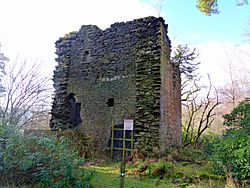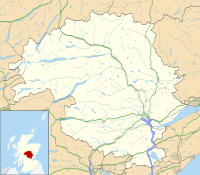Castle Cluggy facts for kids
Quick facts for kids Castle Cluggy |
|
|---|---|
| Ochtertyre, Perth and Kinross, Scotland | |

Ruined tower of Castle Cluggy
|
|
| Coordinates | 56°23′19″N 3°52′51″W / 56.3886°N 3.8807°W |
| Site information | |
| Condition | Ruined |
| Site history | |
| Built | c. 15th century |
Castle Cluggy is a very old castle in Scotland. It was built around the 1400s and is now mostly in ruins. You can find it on the north side of Loch Monzievaird, which is a lake in Perth and Kinross. This historic site is near a place called Ochtertyre. Castle Cluggy was built to replace an even older building that stood there before it.
Contents
What is Castle Cluggy?
Castle Cluggy is what's left of a strong stone tower. It was built in the 15th century, which means the 1400s. Castles like this were often used to protect important families and their lands. Today, only parts of the original castle walls remain. They stand as a reminder of Scotland's long history.
Who Lived at Castle Cluggy?
Over the centuries, different powerful families, known as clans, owned the land where Castle Cluggy stands.
The Comyn Family
In the 14th century (the 1300s), the Comyn family held these lands. Clans were like large family groups in Scotland. They often had their own territories and leaders.
The Drummond Family
Later, in the 15th century (the 1400s), the Drummond family became the owners. They were likely the ones who built the castle we see today. Owning a castle showed a family's power and importance.
The Murray Family
By the 16th century (the 1500s), the Murray family took over the lands. They were another important Scottish clan. The Murrays lived in or used Castle Cluggy for some time.
Why is Castle Cluggy a Ruin?
Castle Cluggy started to fall into ruin by the middle of the 18th century (the 1700s). This happened after the Murray family began building a new, much grander home. This new home was called Ochtertyre House. It was built a bit further north from the old castle. Once the new house was ready, the old castle was no longer needed. Over time, it slowly fell apart and became the ruins we see today.


